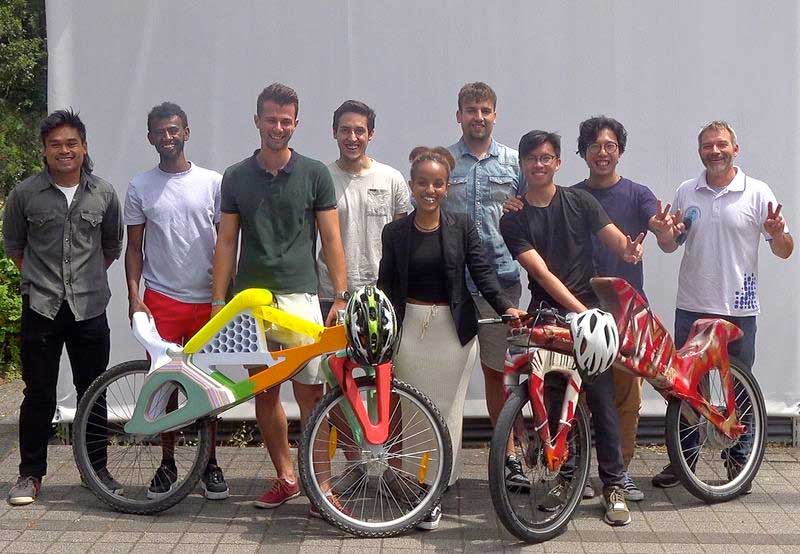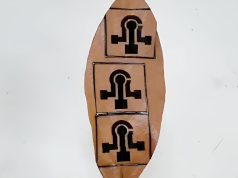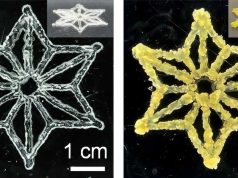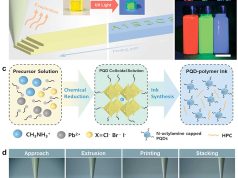In the “Drais3D-Trinational” project, students from three continents come together, primarily online, and work in mixed teams on the task of developing a completely new concept to make the high-tech draisins even lighter and more stable using state-of-the-art design and production methods. “Drais3D-Trinational” is a project of the Baden-Württemberg-STIPENDIUM for Students – BWS plus, a program of the Baden-Württemberg Foundation. The project is funded over three years with a sum of €140,000.
Baron Karl Drais von Sauerbronn is one of Karlsruhe’s best-known sons, who first got around on his draisine in 1817 and is thus considered the forefather of the bicycle. Unlike today’s bicycles, the draisine had no pedals and weighed a proud 40 kilograms.
In the run-up to the 300th anniversary of the city of Karlsruhe, a first high-tech trolley project was created at HKA in 2009, in which stability and weight reduction of the frame were achieved by laminating carbon fibers in the same way, for example, as the wings of the Airbus A380 were manufactured.
“We already have a long-standing university partnership with Universiti Malaysia Pahang, with joint double degree programs,” said project manager on the Karlsruhe University of Applied Sciences (Die HKA) side, Prof. Dr. Maurice Kettner from the Faculty of Mechanical Engineering and Mechatronics. “In the case of the second project partner, it was a happy coincidence for us that an Ethiopian doctoral student and lecturer established contact with her home university and that the Addis Ababa Institute of Technology showed great interest in participating.” For HKA, this is another step toward increasing international networking and mobility, but also of great interest to the DAAD, since international collaborations between German and African universities are underrepresented.
In the three-year project, not only will the Draisine of Baron von Drais be replicated, but the individual parts will be manufactured and assembled using fused deposition modeling – better known as 3D printing. This involves deriving lightweight construction designs from nature (bionics), where the greatest possible strength can be achieved with minimal use of materials, as is the case in the structure of bones or trees, for example. For example, one student team favored a honeycomb-like structure, another took its cue from the structure of bamboo, and the third created a structure similar to a spine with flexible intermediate elements. In order to compensate for the lower strength of the 3D printing materials compared to conventional construction materials, tensile stress-absorbing elements such as tension-resistant packing tapes from former packaging are to be used in a targeted manner – i.e. via upcycling of materials already used elsewhere.
In the first year of the project, three trolley cars were developed in three different countries, which then competed against each other in a hybrid race. The race was broadcast online and the distance and speed covered were determined via GPS trackers. With 490.16 m in 126 seconds, i.e. an average speed of 14 km/h, the mixed team at the HKA was able to clearly win this race in terms of speed, as well as the slalom, although here just ahead of the Ethiopian team. In accordance with the project’s objectives, the winners in four other categories were also determined by majority vote of all team members: The team from Malaysia’s UMP developed the most components based on bionic patterns, and the team from the Addis Ababa Institute of Technology developed the most sustainable trolley. The lightest, at just 8.59 kg, again came from the team at Malaysia’s UMP, and in overcoming problems that arose, the team at the Ethiopian partner university was the most successful.
“In the coming years, we will analyze these designs in terms of their weaknesses and strengths,” says Maurice Kettner, “and the student teams will then design improved prototypes, investigate them computationally and manufacture them themselves in order to further optimize the previous variants technically.”
Subscribe to our Newsletter
3DPresso is a weekly newsletter that links to the most exciting global stories from the 3D printing and additive manufacturing industry.






















